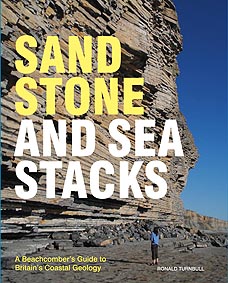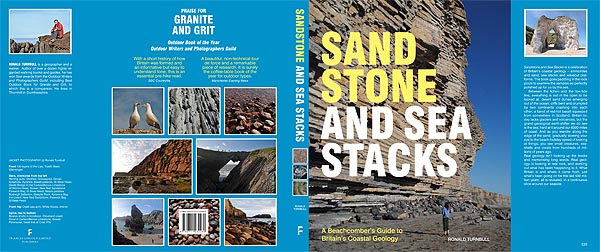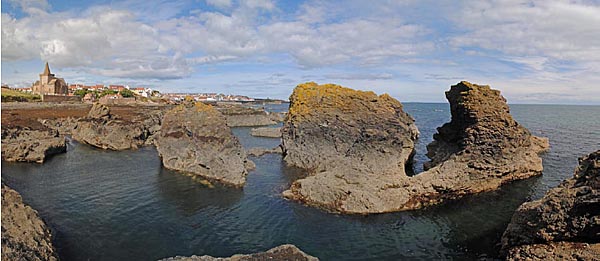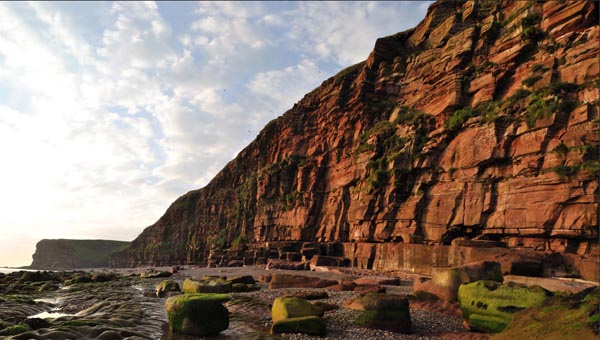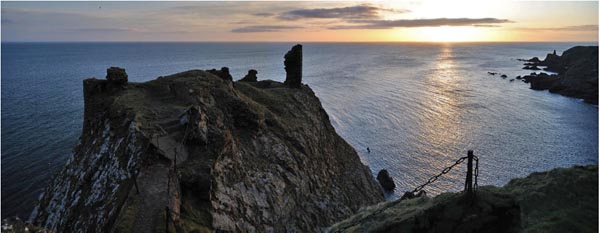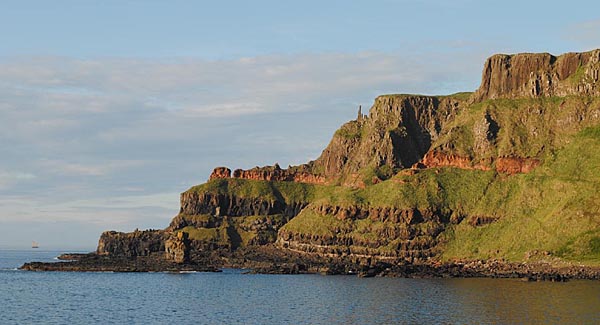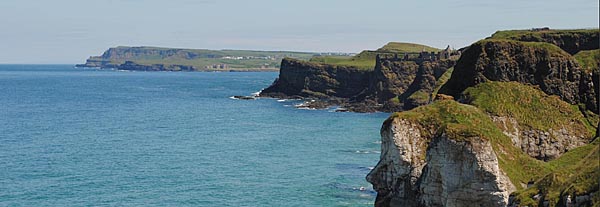Cockburnspath, end of the Southern Upland Way and start of my walk to Fast Castle, has a stone cross at the village centre, a small shop, and a handsome sandstone church hidden among the cottages. At Cove Harbour I passed over round-edged, red-layered sea cliffs, rocks that were obviously made, as Hutton realised, out of earlier sand. The Old Red Sandstone was laid down in rivers or shallow lakes, or still preserves the swirl of a desert sand dune. The wide beach of Pease Bay was the last chance to stop for a swim; and many were doing so, as the tide moved in over the sun-warmed sand. Behind the bay, though, not layered sea-cliffs, but caravans, laid in parallel lines like the natural rock strata that they so conspicuously were not. To travel across the country in a wheeled metal box, so as to live for a few days inside a larger metal box: many find it a satisfying form of fun, going by the size and number of caravan sites all around Britain's coastline. (And a caravan really is a whole lot better than a rucksack for putting those interesting beach pebbles into.)
Beyond Pease Bay the Southern Upland Way turns aside, the lanes end, and the cliffs rise in hard grey rocks to rough fields where turnips grow out of red-brown sandstone soil. At the field corner is an interpretation board, and a steep-dropping grass slope (there's a fence to hang on to) down to the sea and Siccar Point. It was in 1788 that James Hutton arrived here in a small boat, along with his young colleague John Playfair, and a Mr Hall whose father owned the boat. And here, where the red sandstone lies down against the ancient, tilted, grey rocks of Fast Castle, he and those seashore rocks displayed to his friends the incredible ancientness of the Earth.
First the tough grey rocks, themselves a sort of sandstone, had formed in some deep ocean. Then they had been tilted sideways, and raised to form dry land. Some time - a very long time - after that, the sea had flattened the dark grey continent and overrun it. Red sand had covered it, a grain at a time, hundreds of metres deep; and been crushed underneath another ocean into a different, reddish sort of sandstone.
And after all that, the land rose again into the air. The sea attacked it, again. And the old junction of the grey and the red re-emerged, excavated by the waves, to be seen by Mr Hutton and his friend Mr Playfair in their little boat. But before reckoning up all that amazing span of time, just think of one thing more. That grey rock, right at the start, is itself a sort of sandstone. It formed at the bottom of the sea from small grains brought down by rivers from some even earlier land É Playfair, brought up with the idea of a Biblical Earth just 5700 years old, was stunned.
We felt ourselves necessarily carried back to the time when the schistus [the tough greywacke sandstone] on which we stood was yet at the bottom of the sea, and when the [newer, red] sandstone before us was only beginning to be deposited, in the shape of sand or mud, from the waters of a superincumbent ocean. An epoch still more remote presented itself, when even the most ancient of these rocks, instead of standing upright in vertical beds, lay in horizontal planes at the bottom of the sea, and was not yet disturbed by that immeasurable force which has burst asunder the solid pavement of the globe.... The mind seemed to grow giddy by looking so far into the abyss of time. (Transactions of the Royal Society of Edinburgh, vol. V, pt. III, 1805)
Geologists seeing Siccar Point for the first time are sometimes so excited they burst into tears.
So at teatime I stopped off at Siccar Point to pay respects to the spirit of James Hutton Ð and found a TV crew already at it. They'd arrived the authentic way, by sea, and were filming the famous red-meets-grey unconformity in the last moments before the cliff shadow fell across the rocks. They'll be geologising Scotland this winter, unless somebody at Channel Four happens to think up a new six-part drama about nurses or policemen.
You can fit a lot into a six-mile stretch of Scottish coastline. The abyss of time in the afternoon: overnight, the near-infinite ocean.
At dawn I headed up from Fast Castle to the signposts of the new extension of Berwickshire's Coastal Path. They pointed me along field edges and past a decomposing combine harvester, intricate girderwork under the early pink rays of the sun. It wouldn't have looked out of place as an artwork in the big hall of Tate Modern, and fitted equally well at the corner of its clifftop field. But then the path swung around a gorse bush to the tops of great grey cliffs. Those cliffs dropped 150m into a sea that was slaty green, and fringed with white foam in the early sun. A stream chuckled under a footbridge, fell over the cliff edge, and was snatched by the easterly breeze in circles around the next big curve of the cliff.
And here the rocks changed again, from ancient grey to orange and mauve, the volcanic lava of St Abbs Head. On the purple rocks, pink thrift in great bright bunches, and yellow birdsfoot trefoil. Not even at the Tate Modern -- only Nature herself is brave enough for such a colour scheme. Out of green seawater rose the orange and mauve sea stacks, but the ledges of them were dull grey with thousands of squatting guillemots.
The cliff path looks down across tottering chimney-stacks of red basalt to St Abbs village -- after the night in the wilderness, a civilised cup of coffee for breakfast.
|
